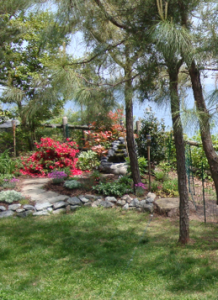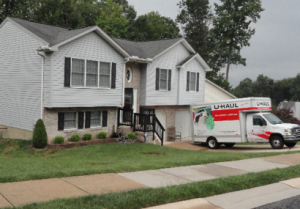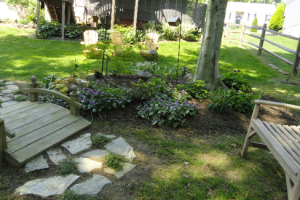
Bayside yard at the Chesapeake
Our home at the Chesapeake was situated on a hill that contributed to issues with stormwater runoff and cliff erosion. Once we settled fulltime at the Bay, we worked to keep water away from the top of the cliff. We built a berm in the front yard with underground pipes taking water to a culvert beside our property. We also planted trees, bushes, groundcover and perennials in the front and bayside yard to help absorb ground water.
When FEMA offered us a buyout in 2012, it meant the house would be demolished and the property returned to its natural state. It also meant all the landscaping features we had installed would be destroyed.

Moving to Elkton, Maryland
After months of house hunting, we found a home in Elkton, Maryland. I was pleased the 15-year-old house lacked real landscaping. It had only basic foundation plants. It gave us a clean slate to plan how the outside of the house would look. We fenced the backyard to protect our dogs and got to work on a landscaping design.
When we moved from the Chesapeake in July 2012 what we wanted most was to bring the bay with us. Since that was not possible, we took as much of the outdoors as we could. We brought our hardscape including a small wooden bridge, fountains, decorative rocks and benches. We also brought plants from the yard.
It was a rainy Saturday when a friend came over and helped us dig up many of our trees and bushes. The same ones he had planted for us over a span of eight years. The rain that day mirrored the sadness the three of us were feeling.
We had rented a truck and filled it to overflowing with those bushes, trees, groundcover and perennials. After a full day’s work, my partner climbed in the truck’s cab and drove our plants up Interstate 95 as I followed in the car.

Our new shade garden in Elkton
A friend from New Jersey who is in the landscape business helped us developed a design for our new yard in Elkton. The plan incorporated plants from the Chesapeake we hoped would survive transplant shock. Fortunately, most are going strong after three years! We were sad when a Japanese maple and Korean dogwood didn’t make it and had to be replaced.
For two years after we moved, I spent many hours working in the yard. Now when we go outside, we smile as we see so many of our Chesapeake transplants thriving in our new yard. We take special joy in our two fringe trees, native to Maryland, with their lovely white blossoms in the spring. Other Chesapeake transplants doing well are the many perennials blooming in our shade garden, a blue-flowering chaste tree and nandina in the front, variegated willow bushes, burning bushes and variety of groundcovers in the backyard. We found new homes for our wooden bridge and benches. And this past summer, we installed our large pottery fountain in the backyard.
The Takeaway: Through no fault of our own, we might have to move on. It might be moving on from a special someone or a special something or somewhere. We all know, moving on can be very difficult. What we keep when we move on is our memories and these memories can last a lifetime. I smile when I think about our time at the Chesapeake. So many happy times shared with loved ones and good friends. So many happy memories.
Let’s start a conversation about a situation or time you had to move and how you handled it. Send me an email. Please provide your name and contact information so I may get in touch for clarification or with a question. I will not print your name. Contact me at [email protected]
